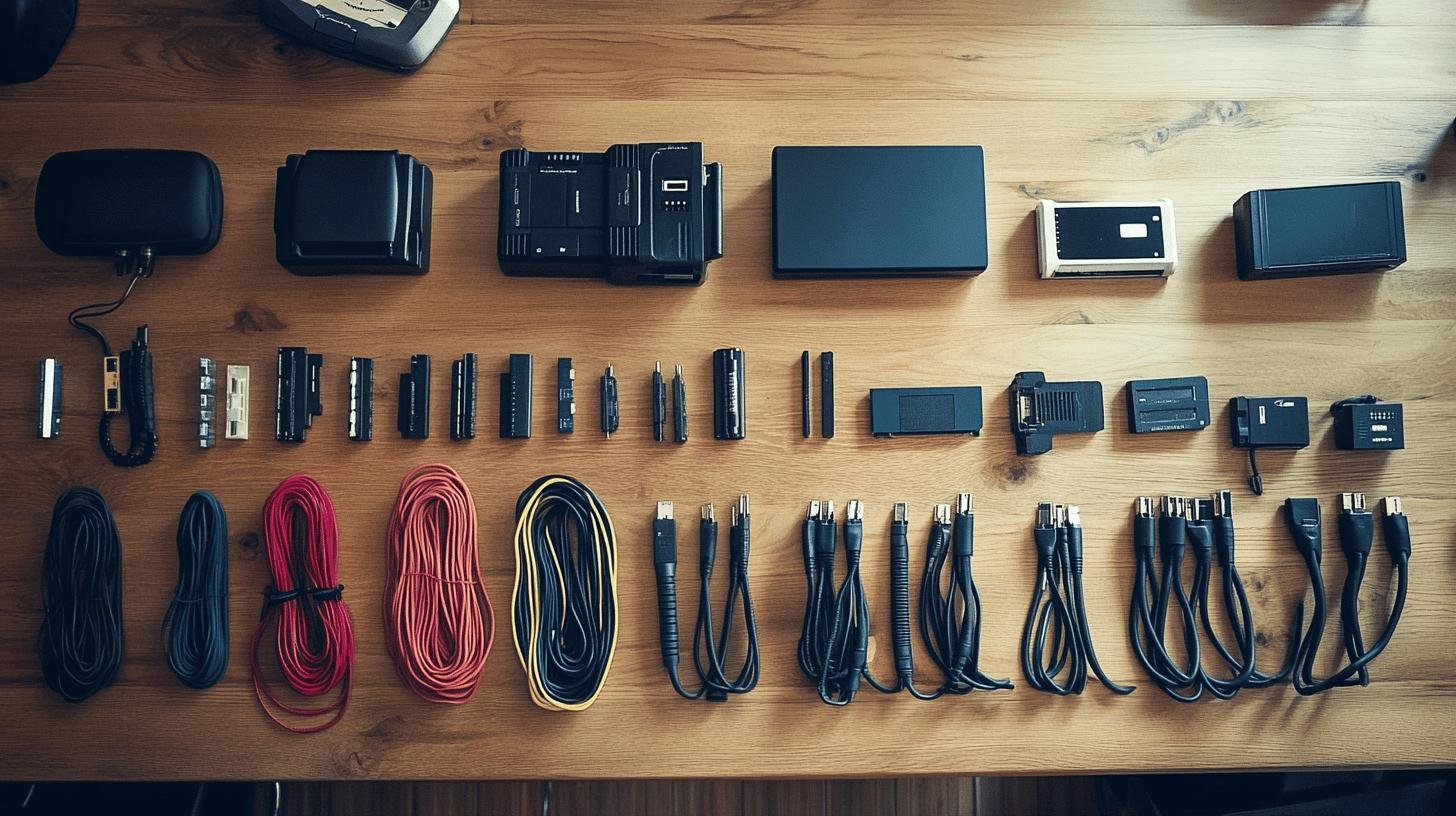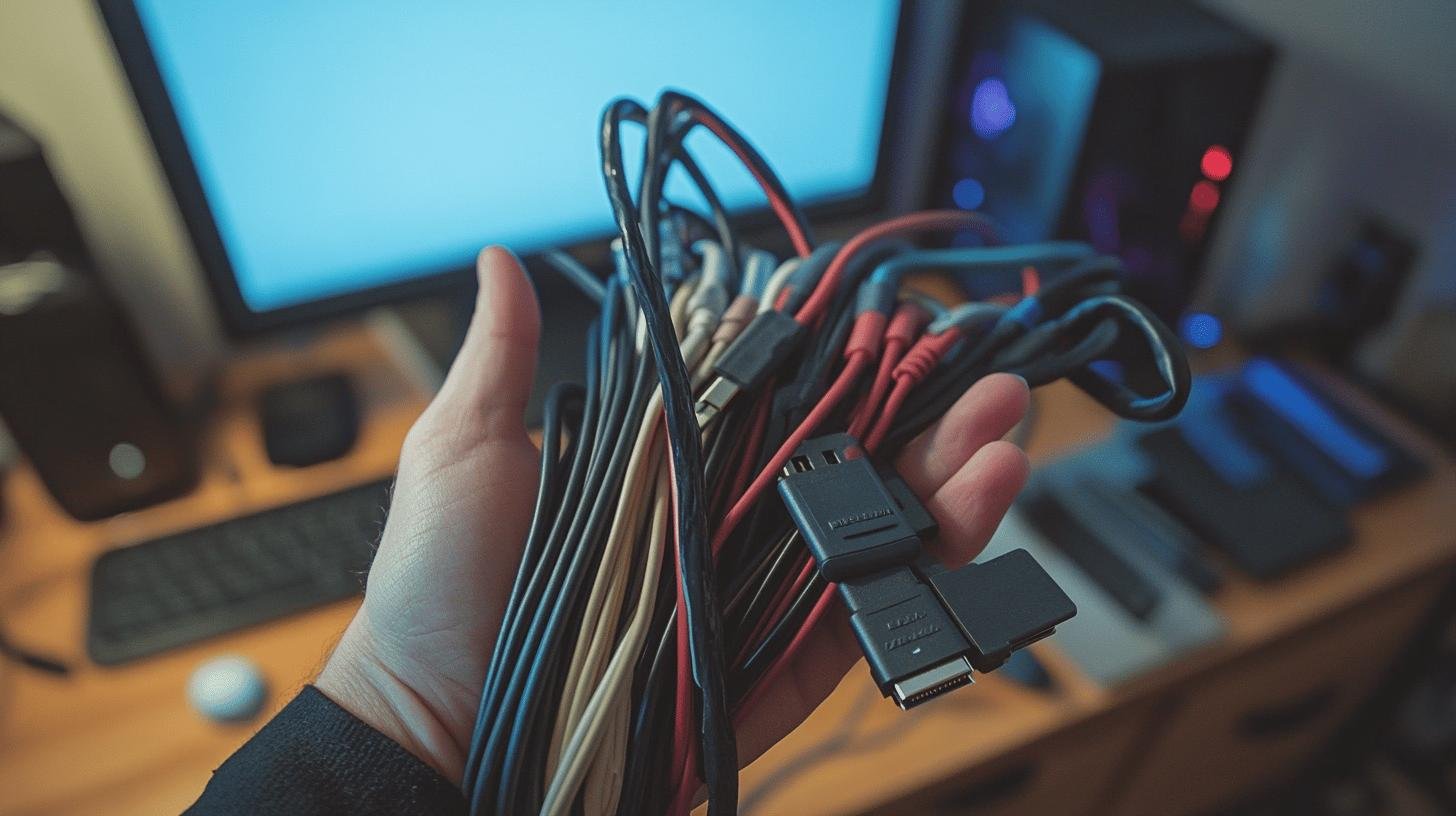TL;DR:
- Cable Types:
- VGA: 15-pin, analog video
- DVI: Analog & digital, types: DVI-A, DVI-D, DVI-I
- Composite Video: Single yellow RCA, analog video
- Component Video: Red, green, blue RCA connectors, higher quality
- Adapters: Needed for modern devices (e.g., VGA to HDMI, DVI to HDMI)
- Check compatibility, resolution support, read reviews, and ensure quality.
- Troubleshooting:
- Check connections, input source, upgrade cables, use correct adapters, and update drivers.
- Purchasing: Available at Amazon, Best Buy, local electronics, and specialty shops; verify compatibility and quality.
Remember the good old days of chunky monitors connected via cables that now seem prehistoric? Ever wondered if those old monitor cables still hold any value or if they’re just relics of a bygone era? This blog post dives into the world of old monitor cables, breaking down the types and their uses. Whether you’re dealing with a vintage VGA or a more versatile DVI, understanding these cables can help revamp your old tech setup or breathe new life into a cherished older monitor. Ready to unravel the mysteries of your dusty cable drawer? Let’s get started.
Types of Old Monitor Cables
Old monitor cables are crucial for connecting older displays to computers and other devices. They allow you to reuse legacy equipment found in schools, offices, and homes. Understanding the types of old monitor cables helps ensure compatibility and optimal performance for your devices.
VGA (Video Graphics Array) cables are among the oldest and most common monitor cables. They have a 15-pin connector and primarily transmit analog video signals. VGA cables were standard for many years, making them prevalent in older monitors and projectors.
DVI (Digital Visual Interface) cables come in several types, including DVI-A, DVI-D, and DVI-I. These cables support both analog and digital signals. DVI-A is for analog, DVI-D for digital, and DVI-I for both. DVI cables offer better image quality than VGA cables, popular during the transition from analog to digital displays.
Composite and Component Video cables use RCA connectors for transmitting analog signals. Composite cables have a single yellow connector for video. Component cables use three connectors—red, green, and blue—for better video quality. Composite cables are common in older consumer electronics like VCRs. Component cables are often found in older home theater systems and professional video equipment.
- VGA: 15-pin connector, analog video
- DVI: Supports analog and digital, types include DVI-A, DVI-D, DVI-I
- Composite Video: Single yellow RCA connector, analog video
- Component Video: Red, green, and blue RCA connectors, better analog video quality
- Common Uses: Found in older monitors, projectors, VCRs, and home theater systems
Identifying Your Old Monitor Cable

Correctly identifying old monitor cables is crucial for compatibility and device functionality. Misidentifying cables can result in poor performance, connection issues, or equipment damage. Knowing the specific type of cable can help find the right adapters and troubleshoot problems.
VGA cables are easy to spot with their typical blue color and 15-pin configuration. These cables are for analog video signals. DVI cables come in three types: DVI-A, DVI-D, and DVI-I. Each type has a unique pin arrangement. DVI-A is for analog signals, DVI-D for digital, and DVI-I supports both.
Composite cables use a single yellow RCA connector to transmit analog video signals. They are common in older consumer electronics like VCRs. Component cables offer better video quality using three RCA connectors colored red, green, and blue. They are often seen in older home theater systems and professional video equipment.
| Cable Type | Identification Features |
|---|---|
| VGA | Blue color, 15-pin connector |
| DVI | Distinct pin configurations for DVI-A, DVI-D, DVI-I |
| Composite Video | Single yellow RCA connector |
| Component Video | Red, green, and blue RCA connectors |
Adapters for Old Monitor Cables
Using old monitor cables with modern devices often requires adapters. These adapters bridge the gap between outdated technology and contemporary devices, ensuring you can still use your older equipment effectively. Adapters are crucial for maintaining compatibility and avoiding the need to replace functional monitors.
Several types of adapters are available, each serving a specific purpose. VGA to HDMI adapters convert analog VGA signals to digital HDMI, making it possible to connect old monitors to newer computers and media devices. DVI to HDMI adapters work similarly, converting DVI signals to HDMI for a seamless connection. VGA to USB adapters are also available for connecting older monitors to USB ports. These adapters often include additional features like audio support and improved resolution.
When choosing an adapter, consider several factors to ensure you select the right one:
- Verify compatibility: Ensure the adapter matches your monitor and device.
- Resolution support: Check if it supports the necessary resolution and refresh rate.
- Read reviews: Look for feedback on reliability and performance.
- Power and drivers: Determine if additional power or drivers are needed.
- Build quality: Choose an adapter with good build quality for durability.
Troubleshooting Common Issues with Old Monitor Cables

When using old monitor cables, common issues like no signal, poor image quality, and compatibility problems often arise. These issues can be frustrating but are typically solvable with basic troubleshooting. Understanding the root causes can help quickly resolve them and ensure a smooth connection.
No signal issues often occur when hooking up an old monitor to a new computer. This can be due to loose connections, incorrect input settings, or compatibility issues with the cable and device. Ensure all cables are securely connected and the correct input source is selected on the monitor.
Poor image quality is usually caused by outdated cables or incorrect resolution settings. Upgrading to a higher-quality cable or adjusting the resolution settings on your computer can improve image clarity.
Using the right adapters is crucial when connecting old monitors to modern devices like laptops or USB ports. For instance, if you’re trying to connect an old monitor to a laptop, you may need a VGA to HDMI or VGA to USB adapter. Ensuring the adapter supports the necessary resolution and refresh rate is key to avoiding display issues. Checking for driver updates and ensuring your system recognizes the adapter can prevent many common problems.
- Check Connections: Ensure all cables are securely connected.
- Select Correct Input: Verify the monitor’s input source is set correctly.
- Upgrade Cables: Use higher-quality cables for better image clarity.
- Use Proper Adapters: Ensure adapters match the resolution and refresh rate needs.
- Update Drivers: Keep drivers updated to ensure the system recognizes the adapter.
Where to Buy Old Monitor Cables and Adapters
Old monitor cables and adapters are readily available at various online marketplaces and local electronics stores. Major online retailers like Amazon and Best Buy offer a wide selection of VGA to HDMI adapters, monitor power cables, and related products.
These platforms often provide customer reviews and detailed product descriptions to help you make informed decisions. Local electronics stores and specialty shops may also carry these items, allowing you to see the products in person before purchasing.
When buying old monitor cables and adapters, ensure compatibility and quality. Start by checking the specifications of your monitor and the device you plan to connect, ensuring the adapter supports the required resolution and refresh rate.
Reading customer reviews can provide insights into the product’s reliability and performance. Look for adapters with warranties or return policies to protect your investment. Finally, consider purchasing from reputable sellers to avoid counterfeit or low-quality products.
- Amazon: Wide selection, customer reviews, detailed descriptions
- Best Buy: Trusted retailer, both online and in-store options
- Local Electronics Stores: Personal inspection before purchase
- Specialty Shops: Expert advice, niche products available
- Reputable Online Sellers: Ensure authenticity and quality
Using Old Monitor Cables with Modern Devices

Connecting old monitor cables to modern devices can be tricky due to differences in technology and signal types. Older cables like VGA and DVI were designed for analog or early digital signals, while modern devices primarily use HDMI and USB-C for high-definition video and audio. This shift creates compatibility issues, requiring additional equipment like adapters to bridge the gap.
Various adapters are available to solve these compatibility issues. HDMI adapters are the most common, allowing you to connect an old VGA or DVI monitor to a device with an HDMI port. For example, a VGA to HDMI adapter converts the analog VGA signal to a digital HDMI signal, enabling the use of older monitors with newer computers and media players. Similarly, a DVI to HDMI adapter can convert DVI signals to HDMI, ensuring a seamless connection. VGA to USB adapters are also available for those who need to connect older monitors to devices lacking traditional display ports.
- Check Cable Condition: Ensure your old cables are in good condition to avoid signal issues.
- Verify Compatibility: Confirm the adapter matches both your monitor and device.
- Resolution Support: Ensure the adapter supports the resolution you need.
- Read Reviews: Look for feedback on the adapter’s reliability and performance.
- Update Drivers: Keep your drivers up to date to ensure the system recognizes the adapter.
Final Words
Diving into the types of old monitor cables, we’ve covered their importance and uses. We explained the differences between VGA, DVI, Composite, and Component cables. Identifying old cables and the available adapters make compatibility easier.
Using the right adapters and troubleshooting tips ensures smooth connections with modern devices. Always check adapters fit and cable conditions for the best results.
Whether you’re seeking a VGA to HDMI adapter or understanding your old monitor cable, the right info makes it easier. Happy connecting!
FAQ
What are old computer monitor cables called?
Old computer monitor cables include VGA, DVI, Composite, and Component cables.
What is the old connection for monitors?
The VGA connection is the oldest, featuring a 15-pin connector for analog video signals.
What is the old type of monitor connection?
The VGA connection is the most common old type of monitor connection, but DVI connections are also considered old.
What cable came with my monitor?
Older monitors typically come with VGA or DVI cables. Check the cable’s connector type to confirm.

